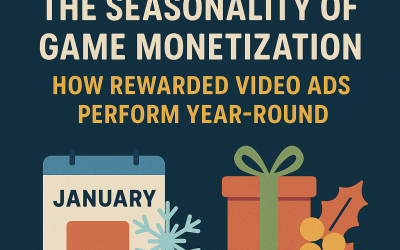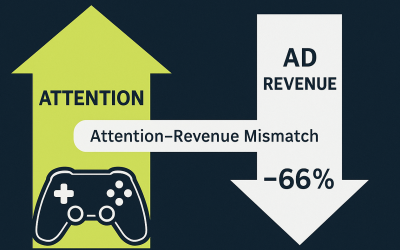Publishers’ Monetization Challenges – 2023 Vs 2024
As we progress into 2024, publishers continue to face a dynamic digital advertising landscape marked by both persistent and evolving challenges. The ad monetization environment is shaped by ongoing regulatory pressures, technological advancements, and shifting consumer behaviors. Understanding these challenges is crucial for publishers aiming to optimize their eCPM and navigate this complex terrain effectively. Here’s a comprehensive look at the key challenges in 2024, compared with 2023.
Contents
- 1 Persistent Monetization Challenges
- 2 Evolving Challenges
- 3 Publisher Challenges in 2024
- 3.0.1 Privacy Regulations and Third-Party Cookies
- 3.0.2 Ad Blocker Usage
- 3.0.3 Platform Dominance
- 3.0.4 Transition to First-Party Data
- 3.0.5 Evolving Ad Technologies
- 3.0.6 Consumer Expectations for Quality Content
- 3.0.7 Economic Fluctuations and Advertising Budgets
- 3.0.8 Effective Measurement and Attribution
Persistent Monetization Challenges
-
Privacy Regulations and Third-Party Cookies
 The ongoing tightening of privacy regulations (such as GDPR in Europe and CCPA in California) and the phasing out of third-party cookies significantly impact ad targeting and personalization capabilities. Privacy regulations mandate strict compliance, limiting the ability of publishers to track user behavior across the web. The deprecation of third-party cookies, crucial for tracking user behavior and delivering personalized ads, has forced publishers to seek alternative strategies. These include investing in first-party data collection, enhancing contextual targeting, and exploring privacy-first advertising solutions. These alternatives require substantial changes to existing data management practices and technology infrastructures, posing both technical and resource-related challenges.
The ongoing tightening of privacy regulations (such as GDPR in Europe and CCPA in California) and the phasing out of third-party cookies significantly impact ad targeting and personalization capabilities. Privacy regulations mandate strict compliance, limiting the ability of publishers to track user behavior across the web. The deprecation of third-party cookies, crucial for tracking user behavior and delivering personalized ads, has forced publishers to seek alternative strategies. These include investing in first-party data collection, enhancing contextual targeting, and exploring privacy-first advertising solutions. These alternatives require substantial changes to existing data management practices and technology infrastructures, posing both technical and resource-related challenges.
-
Ad Blocker Usage
Continuing on Publishers’ Monetization Challenges – 2023 Vs 2024 post, The persistent rise in ad blocker usage challenges publishers’ ability to monetize content effectively. Ad blockers reduce the visibility of ads, directly impacting revenue streams. Publishers must find innovative solutions to counter this trend while maintaining a positive user experience. Strategies include creating high-quality, engaging content that encourages users to disable ad blockers, offering subscription models for an ad-free experience, and developing less intrusive ad formats. Balancing ad revenue generation with user satisfaction is complex, requiring a deep understanding of audience preferences and behaviors.
-
Platform Dominance
The dominance of major platforms like Google and Facebook in digital advertising continues to squeeze the share of ad revenues for publishers. These tech giants control significant portions of the ad market, making it difficult for smaller publishers to compete for advertiser dollars. To attract ad spending, publishers must differentiate themselves through unique content offerings, targeted audience engagement, and innovative ad formats. Developing direct relationships with advertisers and leveraging niche markets can also help mitigate the impact of platform dominance.
Evolving Challenges
-
Transition to First-Party Data
The Focus being eCPM, shifting from third-party data to first-party data collection and processing poses technical and resource-related challenges. Publishers need to invest in technology and strategies to collect, analyze, and leverage first-party data effectively. This transition requires significant changes in data infrastructure, privacy compliance measures, and user engagement tactics. Implementing robust data collection methods, such as user registrations and subscriptions is very essential. In addition employing advanced analytics to derive actionable insights from first-party data are critical steps in this process.
-
Evolving Ad Technologies
Continuing on Publishers’ Monetization Challenges – 2023 Vs 2024 post, keeping pace with fast-evolving ad technologies, standards (such as VAST for video ads), and formats is resource-intensive. The rapid development of new ad formats, such as interactive ads and augmented reality experiences, demands continuous investment in technology and staff training. Publishers must stay abreast of industry standards and technological advancements to exploit new monetization opportunities effectively. This requires a proactive approach to upgrading ad tech stacks, exploring partnerships with ad tech providers, and staying informed about emerging trends.
-
Increased Consumer Expectations for Quality Content
 As consumers become more discerning about the content they consume, publishers face pressure to produce high-quality, engaging content that stands out. The digital landscape is saturated with content, making it challenging to capture and retain audience attention. Publishers need to invest in creating compelling, relevant content that resonates with their target audiences. This includes leveraging multimedia elements, interactive experiences, and personalized content recommendations. Ensuring high production values and maintaining editorial integrity are essential to meeting elevated consumer expectations.
As consumers become more discerning about the content they consume, publishers face pressure to produce high-quality, engaging content that stands out. The digital landscape is saturated with content, making it challenging to capture and retain audience attention. Publishers need to invest in creating compelling, relevant content that resonates with their target audiences. This includes leveraging multimedia elements, interactive experiences, and personalized content recommendations. Ensuring high production values and maintaining editorial integrity are essential to meeting elevated consumer expectations.
-
Economic Fluctuations and Advertising Budgets
Economic uncertainties can lead to fluctuations in advertising spending, affecting publisher revenues. Economic downturns or shifts in market conditions can result in reduced ad budgets, making it imperative for publishers to diversify their revenue streams. Exploring alternative monetization strategies, such as subscription models, e-commerce partnerships, sponsored content, and affiliate marketing, can help mitigate the impact of economic fluctuations. Building resilient business models that can adapt to changing economic conditions is crucial for sustained revenue generation.
Publisher Challenges in 2024
-
Privacy Regulations and Third-Party Cookies
The ongoing tightening of privacy regulations (such as GDPR in Europe and CCPA in California) and the phasing out of third-party cookies significantly impact ad targeting and personalization capabilities. Publishers must find alternative strategies for audience targeting and measurement that comply with these privacy constraints.
-
Ad Blocker Usage
The persistent rise in ad blocker usage challenges publishers’ ability to monetize content effectively. Finding a balance between ad revenue and user experience, while encouraging users to either whitllist or approve their sites or subscribe for an ad-free experience, remains a complex issue.
-
Platform Dominance
The dominance of major platforms like Google and Facebook in digital advertising continues to squeeze the share of ad revenues for publishers. Competing with these platforms for advertiser dollars requires innovative approaches and differentiation in content and audience engagement.
-
Transition to First-Party Data
Shifting from third-party data to first-party data collection and processing poses technical and resource-related challenges. Publishers need to invest in technology and strategies to collect, analyze, and leverage first-party data effectively for ad targeting and personalization.
-
Evolving Ad Technologies
Keeping pace with fast-evolving ad technologies, standards (such as VAST for video ads), and formats is resource-intensive. Publishers must continually upgrade their ad tech stacks and skills to exploit new monetization opportunities, like interactive or augmented reality ads.
-
Consumer Expectations for Quality Content
As consumers become more discerning about the content they consume, publishers face pressure to produce high-quality, engaging content that stands out. This requires investment in content creation and distribution, which can strain budgets.

-
Economic Fluctuations and Advertising Budgets
Economic uncertainties can lead to fluctuations in advertising spending, affecting publisher revenues. Staying adaptable and diversifying revenue streams beyond traditional advertising, such as through subscriptions or e-commerce partnerships, can help mitigate these risks.
-
Effective Measurement and Attribution
With changes in tracking capabilities and increased privacy concerns, developing effective measurement and attribution models that accurately assess ad performance and ROI is challenging. Publishers need to innovate in analytics and reporting to provide value to advertisers.
Before I finish up on my Publishers’ Monetization Challenges – 2023 Vs 2024 post, Addressing these challenges requires a strategic approach centered on innovation, user engagement, privacy compliance, and diversification of revenue streams. Publishers that successfully navigate these issues will be better positioned to sustain and grow their ad monetization efforts. If you need any more information on anything (we mean anything) related to Ad Monetization and Rewarded Video Ads, you can reach to us at info@blog.applixir.com – AppLixir.




